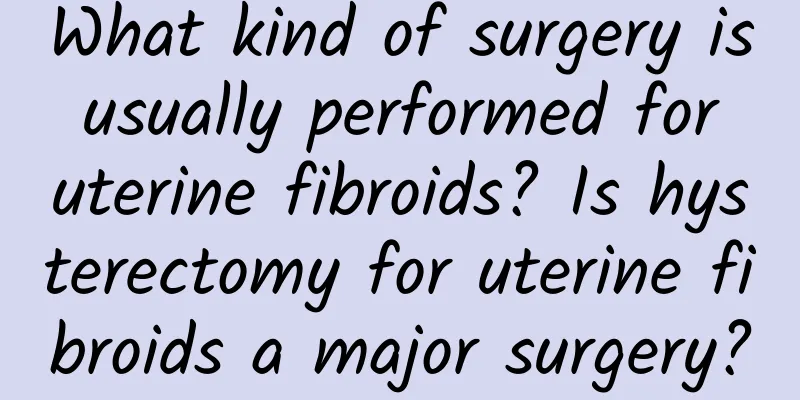What kind of surgery is usually performed for uterine fibroids? Is hysterectomy for uterine fibroids a major surgery?

|
What kind of surgery is usually performed for uterine fibroids? Is hysterectomy for uterine fibroids a major surgery? Introduction: It is important for patients to understand the types of surgery for uterine fibroids to ensure that they receive the most appropriate treatment. This article will introduce the common types of surgery for uterine fibroids and the nature and risks of hysterectomy. Types of Uterine Fibroid Surgery Uterine fibroids are one of the most common tumors in the female reproductive organs, and many patients require surgery to treat them. Types of surgery for uterine fibroids include medical therapy, conservative surgery, and resection. Medical therapy can be used to control symptoms and relieve pain, but it cannot completely cure fibroids. When medical therapy is ineffective or the condition is severe, conservative surgery and resection are usually the treatment options. 2. Applicability of conservative surgery Conservative surgery is a minimally invasive procedure to remove uterine fibroids using laparoscopic or hysteroscopic techniques. Laparoscopic surgery involves inserting a camera and surgical tools into the abdominal cavity through a small incision in the abdomen. Hysteroscopic surgery involves inserting a camera and surgical tools into the uterine cavity. Conservative surgery is a good option for women who wish to preserve their uterus and fertility. The necessity of hysterectomy However, not all uterine fibroids are suitable for conservative surgery. In some cases, the fibroids may be too large or too numerous to be removed with conservative surgery. At this point, a hysterectomy becomes a necessary option. A hysterectomy is a surgical procedure to completely remove the uterus, either through an open abdomen or laparoscopy, and is often used to treat conditions such as severe uterine fibroids, endometriosis, and uterine cancer. A hysterectomy is a major surgery that involves deep manipulation of the pelvis and pelvic organs. 4. Risks and precautions of hysterectomy Hysterectomy is a relatively complex surgery, and patients need to fully understand the risks and precautions of the surgery. Surgical risks may include postoperative pain, blood loss, infection, and incision healing problems. Complications such as urinary incontinence, sexual dysfunction, and osteoporosis may also occur after surgery. Before the operation, the doctor will conduct a comprehensive evaluation and examination of the patient to determine the suitability and prognosis of the operation. The choice of surgery for uterine fibroids should be made on an individual basis. Conservative surgery is suitable for patients who wish to preserve their uterus and fertility, while hysterectomy is suitable for patients with large or excessive uterine fibroids. However, no matter which surgery is chosen, patients should fully understand the risks and precautions of the surgery and actively communicate with their doctors. I hope this article can provide some useful information for patients who are concerned about uterine fibroid surgery. |
>>: Why do fibroids grow outside the uterus? What causes fibroids outside the uterus?
Recommend
The cost of painless abortion surgery includes these items
Painless abortion is one type of abortion surgery...
Can female pelvic inflammatory disease heal itself?
Female pelvic inflammatory disease (PID) refers t...
What are the common symptoms of pelvic inflammatory disease?
What are the common symptoms of pelvic inflammato...
How to treat benign uterine fibroids? Nursing methods for patients with benign uterine fibroids
As one of the most common benign tumors, uterine ...
What are the early symptoms of vulvar leukoplakia and how to treat it in the early stage
What are the early symptoms of vulvar leukoplakia...
What are the daily nursing tasks for preventing and treating dysmenorrhea?
What are the daily nursing tasks for preventing a...
What are the abortion examination items? There are these 5 types
Regardless of the cause of miscarriage, women sho...
A must-have for weight loss! Eating konjac and agar is very satisfying
You know you need to eat less to lose weight, but...
How much does cervical erosion surgery cost?
How much does the surgery for cervical erosion co...
Will having Bartholinitis in a 6-month pregnancy affect fertility?
Bartholinitis is an inflammation caused by infect...
Women should pay attention to the causes of ectopic pregnancy
Ectopic pregnancy is a common female disease. In ...
Adnexitis has different clinical manifestations in acute and chronic conditions.
Adnexitis has different clinical manifestations i...
Long-term constipation, intestinal perforation, fecal stones, and inflammation
People often say, "If you have constipation,...
Drink unsweetened soy milk 30 minutes before meals to increase satiety
With the arrival of the long summer vacation, chi...
What are the symptoms of cervical hypertrophy?
What are the symptoms of cervical hypertrophy? Ce...









